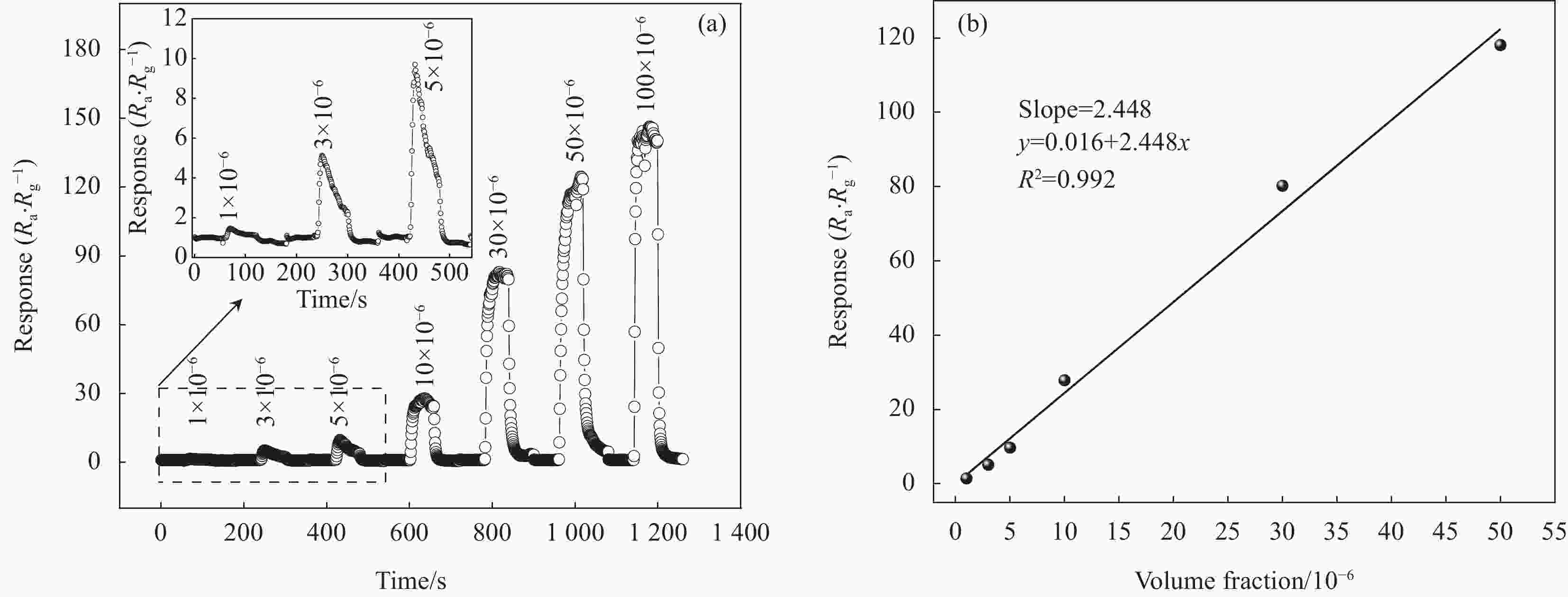Gas sensing performance and preparation of WO3 nanosheets decorated by ZIF-67
-
摘要: 金属氧化物半导体气敏传感器在有毒有害气体检测领域逐渐表现出巨大的应用前景,但是金属氧化物半导体传感器通常在检测时受环境湿度影响较大,这极大地限制了其应用。本文采用水热法成功在陶瓷管表面原位生长WO3纳米片,并以此为基底,在其表面生长ZIF-67多孔材料,通过调控W和Co的比例制备了不同比例的ZIF-67/WO3复合材料,利用XRD、SEM、FTIR和比表面积测试仪(BET)等方法对所制备的材料进行物相和形貌表征。针对其不同比例的复合材料的气敏性能进行了研究。结果表明:W∶Co摩尔比为 1∶1的ZIF-67/WO3(1∶1)复合材料性能最好,在220℃对三乙胺表现出优异的选择性,对体积分数为100×10−6的三乙胺的响应值可达140.34,响应和恢复时间分别为9 s和7 s。研究了空气相对湿度(RH)对ZIF-67/WO3(1∶1)传感器的影响,结果表明,在高达75%RH环境下该材料仍能保持较好的响应值,相对于纯WO3气敏材料具有较好的抗湿性能。Abstract: Metal oxide semiconductor gas sensors are exhibiting great application prospects in the field of toxic and hazardous gas detection gradually, but metal oxide semiconductor sensors are commonly affected by ambient humidity during detection, which significantly limits their applications. In this paper, WO3 nanosheets were successfully in situ grown on the surface of ceramic tubes by hydrothermal method, and ZIF-67 porous materials were grown on the surface of ceramic tubes using it as substrate. Different ZIF-67/WO3 composites were prepared by adjusting the proportion of W and Co. The structures and morphologies of different ZIF-67/WO3 composites were analyzed via XRD, SEM, FTIR and BET techniques. The gas sensing properties of the pristine and different ZIF-67/WO3 composites are investigated. The results indicate that the ZIF-67/WO3(1∶1) composite which W∶Co molar ratio is 1∶1 has the best performance with excellent selectivity to trimethylamine (TEA) at 220℃, and high response of 140.34 to TEA gas with volume fraction of 100×10−6. The response/recovery time is 9 s and 7 s, respectively. The effect of air relative humidity (RH) on the sensors has also studied. The results show that the ZIF-67/WO3(1∶1) sensor can maintain a good response value in an environment humidity up to 75%RH and has a good moisture resistance compared with the pristine WO3 gas sensing material.
-
Key words:
- WO3 /
- ZIF-67 /
- composites /
- in situ /
- trimethylamine /
- humidity resistance /
- gas sensing
-
图 5 (a) ZIF-67/WO3(1∶1)元件对100×10−6三乙胺的响应曲线;(b)不同元件在220℃对三乙胺的响应恢复时间
Tres and Trec—Response and recovery time, respectively, which defined as the time required to reaching 90% of the total resistance change after exposure to the target gas and air, respectively
Figure 5. (a) Response curve of the ZIF-67/WO3(1∶1) sensor to 100×10−6 triethylamine; (b) Response/recovery time of different sensors to triethylamine at 220℃
图 6 (a) ZIF-67/WO3(1∶1)元件在220℃对不同浓度三乙胺的动态响应曲线(插图为低浓度的放大图);(b) 体积分数1×10−6~50×10−6的响应线性关系
R2—Linearly dependent coefficient
Figure 6. (a) Dynamic response curves of the ZIF-67/WO3(1∶1) sensor to different concentrations of triethylamine at 220℃ (Inset is an enlarged view of low concentration); (b) Linear relation of volume fraction 1×10−6-50×10−6
表 1 ZIF-67/WO3复合材料的原料配比
Table 1. Raw material ratios of ZIF-67/WO3 composites
Sample Molar ratio n(W)∶n(Co) ZIF-67/WO3(5∶1) 5∶1 ZIF-67/WO3(1∶1) 1∶1 ZIF-67/WO3(1∶5) 1∶5 表 2 不同敏感材料对于三乙胺气敏性能对比
Table 2. Compared TEA sensing performance of different sensing materials
Material Volume fraction/10−6 Response (Ra/Rg) Temperature
/℃Tres/Trec/s Ref. ZnO 50 83.00 280 8/23 [30] WO3/h-BN-5 500 390.60 260 8/60 [31] WO3 50 16.00 220 1.5/22 [32] Pd NPs-In2O3 50 47.56 220 4/17 [33] SnO2/SiO2 50 8.27 280 –/– [34] SnO2 50 54.90 235 26/13 [1] 2%Ga-doped Co3O4 50 108.00 180 3/15 [35] ZIF-67/WO3(1∶1) 50 118.08 220 9/7 This work Notes: h-BN—Hexagonal boron nitride; NPs—Nanoparticles. -
[1] XU D, CHEN Y, QIU T, et al. Hierarchical mesoporous SnO2 nanotube templated by staphylococcus aureus through electrospinning for highly sensitive detection of triethylamine[J]. Materials Science in Semiconductor Processing,2021,136:106-129. [2] ZHAI C, LUO Z, LIANG X, et al. A superior selective and anti-jamming performance triethylamine sensing sensor based on hierarchical WO3 nanoclusters[J]. Journal of Alloys and Compounds,2021,857:157545. doi: 10.1016/j.jallcom.2020.157545 [3] SHEN Z, ZHANG X, MI R, et al. On the high response towards TEA of gas sensors based on Ag-loaded 3D porous ZnO microspheres[J]. Sensors and Actuators B: Chemical,2018,270:492-499. doi: 10.1016/j.snb.2018.05.034 [4] HOU X, GAO Y, JI H, et al. Enhanced triethylamine-sensing properties of hierarchical molybdenum trioxide nanostructures derived by oxidizing molybdenum disulfide nanosheets[J]. Journal of Colloid and Interface Science,2022,605:624-636. doi: 10.1016/j.jcis.2021.07.053 [5] WANG H, LUO Y, LI K, et al. Porous α-Fe2O3 gas sensor with instantaneous attenuated response toward triethylamine and its reaction kinetics[J]. Chemical Engineering Journal,2022,427:131631. doi: 10.1016/j.cej.2021.131631 [6] TIAN K, ZHANG W, SUN S N, et al. Design and fabrication of spinel nanocomposites derived from perovskite hydroxides as gas sensing layer for volatile organic compounds detection[J]. Sensors and Actuators B: Chemical,2021,329:129076. doi: 10.1016/j.snb.2020.129076 [7] WANG C. Triethylamine sensing properties of ZnO nanostructures prepared by hydrothermal method at different pH values[J]. Chemical Physics Letters,2020,749:137471. doi: 10.1016/j.cplett.2020.137471 [8] ULLAH KHAN H, TAPIQ M, SHAH M, et al. Exploring the NH3 gas sensing efficiency of polyvinylpyrrolidone based tungsten trioxide (PVP/WO3) nanocomposites: A recent progression in the toxic gas sensing materials[J]. Materials Science and Engineering: B,2021,273:115422. doi: 10.1016/j.mseb.2021.115422 [9] KHUDADAD A I, YOUSIF A A, ABED H R. Effect of heat treatment on WO3 nanostructures based NO2 gas sensor low-cost device[J]. Materials Chemistry and Physics,2021,269:124731. doi: 10.1016/j.matchemphys.2021.124731 [10] KUMARESAN M, VENKATACHALAM M, SAROJA M, et al. TiO2 nanofibers decorated with monodispersed WO3 heterostruture sensors for high gas sensing performance towards H2 gas[J]. Inorganic Chemistry Communications,2021,129:108663. doi: 10.1016/j.inoche.2021.108663 [11] GUI Y H, YANG L L, TIAN K, et al. P-type Co3O4 nanoarrays decorated on the surface of n-type flower-like WO3 nanosheets for high-performance gas sensing[J]. Sensors and Actuators B: Chemical,2019,288:104-112. doi: 10.1016/j.snb.2019.02.101 [12] NAKATE U T, YU Y T, PARK S. High performance acetaldehyde gas sensor based on p-n heterojunction interface of NiO nanosheets and WO3 nanorods[J]. Sensors and Actuators B: Chemical,2021,344:130264. doi: 10.1016/j.snb.2021.130264 [13] WANG X X, TIAN K, LI H Y, et al. Bio-templated fabrication of hierarchically porous WO3 microspheres from lotus pollens for NO gas sensing at low temperatures[J]. RSC Advances,2015,5(37):29428-29432. doi: 10.1039/C5RA02536B [14] KUMAR R, LIU X, ZHANG J, et al. Room-temperature gas sensors under photoactivation: From metal oxides to 2D materials[J]. Nano-Micro Letters,2020,12:164. doi: 10.1007/s40820-020-00503-4 [15] HU C, XU J, LU Z, et al. Core-shell structured ZIF-7@ZIF-67 with high electrochemical performance for all-solid-state asymmetric supercapacitor[J]. International Journal of Hydrogen Energy,2021,46(63):32149-32160. doi: 10.1016/j.ijhydene.2021.06.225 [16] HUANG B, LI Y, ZENG W. Application of metal-organic framework-based composites for gas sensing and effects of synthesis strategies on gas-sensitive performance[J]. Chemosensors,2021,9(8):226. doi: 10.3390/chemosensors9080226 [17] YANG T, GAO L, WANG W, et al. Berlin green framework-based gas sensor for room-temperature and high-selecti-vity detection of ammonia[J]. Nano-Micro Letters,2021,13:63. doi: 10.1007/s40820-020-00586-z [18] CHEN J, LV H, BAI X, et al. Synthesis of hierarchically porous Co3O4/biomass carbon composites derived from MOFs and their highly NO2 gas sensing performance[J]. Microporous and Mesoporous Materials,2021,321:111108. doi: 10.1016/j.micromeso.2021.111108 [19] QIN Y, WANG X, ZANG J. Room-temperature ethanol sensor based on ZIF-67 modified silicon nanowires with expanded detection range and enhanced moisture resistance[J]. Chemical Physics Letters,2021,765:138302. doi: 10.1016/j.cplett.2020.138302 [20] GARG N, KUMAR M, KUMARI N, et al. Chemoresistive room-temperature sensing of ammonia using zeolite imidazole framework and reduced graphene oxide (ZIF-67/rGO) composite[J]. ACS Omega,2020,5(42):27492-27501. doi: 10.1021/acsomega.0c03981 [21] LI Y, LI K, LUO Y, et al. Synthesis of Co3O4/ZnO nano-heterojunctions by one-off processing ZIF-8@ZIF-67 and their gas-sensing performances for trimethylamine[J]. Sensors and Actuators B: Chemical,2020,308:127657. doi: 10.1016/j.snb.2020.127657 [22] TAN J, HUSSAIN S, GE C, et al. ZIF-67 MOF-derived unique double-shelled Co3O4/NiCo2O4 nanocages for superior gas-sensing performances[J]. Sensors and Actuators B: Che-mical,2020,303:127251. doi: 10.1016/j.snb.2019.127251 [23] WU X, XIONG S, GONG Y, et al. MOF-SMO hybrids as a H2S sensor with superior sensitivity and selectivity[J]. Sensors and Actuators B: Chemical,2019,292:32-39. doi: 10.1016/j.snb.2019.04.076 [24] ZHOU Y, ZHOU T, ZHANG Y, et al. Synthesis of core-shell flower-like WO3@ZIF-71 with enhanced response and selectivity to H2S gas[J]. Solid State Ionics,2020,350:115278. doi: 10.1016/j.ssi.2020.115278 [25] SUN Z, LIAO T, DOU Y, et al. Generalized self-assembly of scalable two-dimensional transition metal oxide nanosheets[J]. Nature Communications,2014,5(1):3813. doi: 10.1038/ncomms4813 [26] GUI Y H, WANG H Y, TIAN K, et al. Enhanced gas sensing properties to NO2 of SnO2/rGO nanocomposites synthesized by microwave-assisted gas-liquid interfacial method[J]. Ceramics International,2018,44(5):4900-4907. doi: 10.1016/j.ceramint.2017.12.080 [27] MOHAN L, AVANI A V, KATHIRVEL P, et al. Investigation on structural, morphological and electrochemical properties of Mn doped WO3 nanoparticles synthesized by co-precipitation method for supercapacitor applications[J]. Journal of Alloys and Compounds,2021,882:160670. doi: 10.1016/j.jallcom.2021.160670 [28] ABBASPOOR M, ALIANNEZHADI M, TEHRNAI F S. Effect of solution pH on as-synthesized and calcined WO3 nanoparticles synthesized using sol-gel method[J]. Optical Materials,2021,121:111552. doi: 10.1016/j.optmat.2021.111552 [29] WANG Q, ZHANG Z, SHI S, et al. Highly active cobalt- and nitrogen-doped carbon derived from ZIF-67@melamine towards oxygen reduction reaction[J]. Journal of Electroanalytical Chemistry,2021,894:115397. doi: 10.1016/j.jelechem.2021.115397 [30] LI W, XU H, YU H, et al. Different morphologies of ZnO and their triethylamine sensing properties[J]. Journal of Alloys and Compounds,2017,706:461-469. doi: 10.1016/j.jallcom.2017.02.223 [31] TIAN W, WANG Y, ZHANG Y, et al. WO3 nanoflakes coupled with hexagonal boron nitride nanosheets for triethylamine sensing[J]. ACS Applied Nano Materials,2021,4:6316-6327. [32] ZHAI C, ZHU M, JIANG L, et al. Fast triethylamine gas sensing response properties of nanosheets assembled WO3 hollow microspheres[J]. Applied Surface Science,2019,463:1078-1084. doi: 10.1016/j.apsusc.2018.09.049 [33] LIU X, ZHAO K, SUN X, et al. Rational design of sensitivity enhanced and stability improved TEA gas sensor assembled with Pd nanoparticles-functionalized In2O3 composites[J]. Sensors and Actuators B: Chemical,2019,285:1-10. [34] MENG F, LIAO Z, XING C, et al. Preparation of SnO2/SiO2 nanocomposites by sol-gel method for enhancing the gas sensing performance to triethylamine[J]. Journal of Alloys and Compounds,2021,893:162189. [35] SUN H, TANG X, ZHANG J, et al. MOF-derived bow-like Ga-doped Co3O4 hierarchical architectures for enhanced triethylamine sensing performance[J]. Sensors and Actuators B: Chemical,2021,346:130546. doi: 10.1016/j.snb.2021.130546 [36] TIAN W, WANG Y, ZHANG Y, et al. WO3 nanoflakes coupled with hexagonal boron nitride nanosheets for triethylamine sensing[J]. ACS Applied Nano Materials,2021,4(6):6316-6327. doi: 10.1021/acsanm.1c01165 [37] ZHANG L, KHAN K, ZOU J, et al. Recent advances in emerging 2D material-based gas sensors: Potential in disease diagnosis[J]. Advanced Materials Interfaces,2019,6(22):1901329. doi: 10.1002/admi.201901329 [38] XU K, ZHAN C, ZHAO W, et al. Tunable resistance of MOFs films via an anion exchange strategy for advanced gas sensing[J]. Journal of Hazardous Materials,2021,416:125906. doi: 10.1016/j.jhazmat.2021.125906 [39] YOGAPRIYA R, DATTA K K R. Porous fluorinated graphene and ZIF-67 composites with hydrophobic-oleophilic properties towards oil and organic solvent sorption[J]. Journal of Nanoscience and Nanotechnology,2020,20:2930-2938. doi: 10.1166/jnn.2020.17465 -






 下载:
下载:











